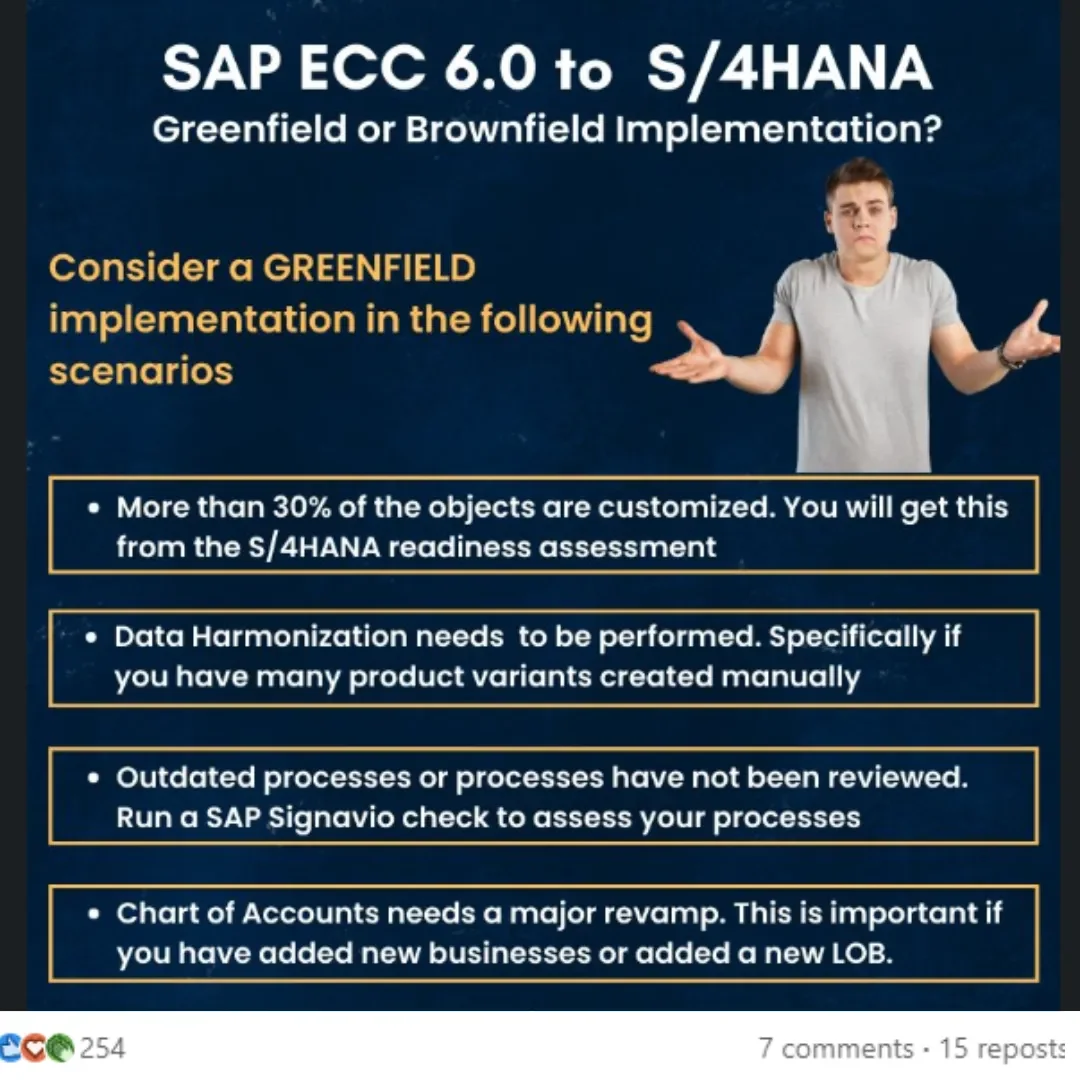AI Governance: Are You in Control, or Is AI Controlling You?
Regulations are tightening, risks are rising—don’t wait until it’s too late. Discover how to govern AI before it governs you.
AI is revolutionizing SAP implementations, but without proper governance, it can lead to compliance failures, security breaches, and costly errors. Regulations are tightening, and businesses can’t afford AI risks in critical ERP systems. Learn how to enforce accountability, manage AI-driven decisions, and align governance with your SAP strategy before issues arise.
Noel's been featured on





AI Governance in SAP Implementations: Ignoring Can Cost You Big
AI is deeply embedded in modern SAP systems, but without proper governance, it can lead to compliance failures, security breaches, and costly errors. With regulations tightening, businesses must ensure AI-driven decisions align with accountability and transparency. This blog explores how to implement AI governance in SAP projects to mitigate risks and drive success.
Frequently Asked Questions
AI is transforming how businesses use SAP—automating financial decisions, optimizing HR processes, and streamlining supply chains. But without governance, things can go very wrong. Imagine an AI-powered SAP recruitment tool unintentionally favoring one demographic over another or an automated finance approval process greenlighting high-risk transactions. That’s not just a tech issue; it’s a business risk.
SAP’s AI-driven systems, like S/4HANA, SuccessFactors, and SAP BTP, are powerful. But without oversight, they can introduce bias, expose sensitive data, and even violate regulations like GDPR, ISO 42001, and the AI Act. Compliance failures lead to hefty fines, reputational damage, and operational chaos. No company wants that.
So how do you keep AI in check while reaping the benefits? That’s where AI governance comes in. It’s about transparency, accountability, and security—ensuring that AI decisions in SAP are fair, explainable, and legally compliant.
1. What is AI governance in SAP implementations?
AI governance in SAP refers to the framework of policies, processes, and controls that guide how AI is used within SAP applications. It ensures AI-driven decisions align with business objectives, comply with regulations, and maintain transparency, fairness, and accountability.
Governance is crucial in managing AI’s risks—such as bias, data security breaches, and compliance violations—while maximizing its potential for efficiency and automation in SAP environments like S/4HANA, SuccessFactors, and SAP BTP.
2. Why is AI governance crucial for SAP systems?
Without strong governance, AI in SAP can lead to non-compliance with GDPR, data privacy violations, and biased decision-making in HR, finance, and procurement. AI models without oversight may deny job applications unfairly, process inaccurate financial transactions, or expose sensitive customer data. Governance frameworks prevent these issues by enforcing explainability, auditability, and regulatory alignment in AI-powered workflows.
Example: In SAP SuccessFactors, an AI-driven recruitment tool without governance might prioritize certain demographic groups over others, leading to discriminatory hiring practices. AI governance ensures bias detection, fairness audits, and transparent decision-making to prevent such risks.
3. How does AI governance enhance data security in SAP?
SAP systems manage vast amounts of sensitive financial, HR, and operational data. AI governance protects this data by enforcing security measures such as:
- Data encryption and anonymization to prevent unauthorized access.
- Strict access controls for AI-powered analytics tools.
- Real-time AI anomaly detection to flag suspicious activities.
AI governance also ensures compliance with ISO 42001, GDPR, and industry-specific security standards, reducing the risk of data breaches, identity theft, and financial fraud.
4. What are the key components of an effective AI governance framework in SAP?
An AI governance framework within SAP should include:
✔ AI Policy Development – Define rules for AI model deployment, decision-making, and user responsibility in SAP applications.
✔ Bias & Fairness Audits – Regularly review AI models in HR, finance, and procurement to prevent discrimination.
✔ Security & Compliance Monitoring – Ensure AI aligns with regulations like GDPR, AI Act, and IFRS while securing SAP databases.
✔ AI Explainability & Transparency – Maintain documentation of AI logic and decision-making processes.
✔ Continuous Auditing & Risk Assessments – Track AI performance in real-time, preventing model drift and unintended consequences.
5. How can organizations align AI governance in SAP with regulatory standards?
To stay compliant, organizations should map AI governance policies to global and local regulations, such as:
- GDPR (General Data Protection Regulation) – Ensures AI-driven data processing follows privacy laws.
- EU AI Act – Defines risk categories for AI applications in HR, healthcare, and finance.
- ISO 42001 – AI-specific risk management and security framework for enterprise AI.
- HIPAA (for healthcare AI in SAP) – Ensures patient data protection when AI is used in SAP for medical billing and reporting.
Aligning governance requires regular AI audits, compliance training, and real-time monitoring tools integrated into SAP AI workflows.
6. What role does continuous monitoring play in AI governance within SAP?
AI systems evolve over time, which means risks aren’t static. Continuous monitoring:
- Tracks AI outputs in real-time to detect anomalies.
- Prevents model drift, ensuring AI decisions remain consistent and reliable.
- Enhances accountability by keeping AI audits up to date.
For example, an AI-powered fraud detection system in SAP Finance & Controlling (FICO) might start misidentifying legitimate transactions as fraud if it isn’t monitored and adjusted regularly. AI governance ensures periodic re-training and validation of AI models to maintain accuracy.
7. How can businesses ensure ethical AI use in SAP implementations?
To make AI ethical in SAP, businesses should:
- Train AI models on diverse datasets to avoid biases.
- Implement fairness-aware machine learning techniques in AI-powered SAP HR and finance tools.
- Ensure AI-driven decisions are auditable and explainable to users.
- Appoint an AI Ethics Committee to review SAP AI models periodically.
Without these safeguards, AI in SAP could unintentionally reinforce biases, such as discriminatory hiring practices, unfair loan approvals, or biased customer service responses.
8. What are the potential risks of neglecting AI governance in SAP systems?
Ignoring AI governance in SAP can lead to:
⚠ Regulatory Fines – GDPR violations can result in penalties up to €20 million or 4% of annual revenue.
⚠ Unethical Decision-Making – Unchecked AI could reject qualified job candidates or favor biased financial approvals.
⚠ Security Breaches – AI models processing sensitive financial data without proper encryption can expose SAP systems to cyberattacks.
⚠ Loss of Customer Trust – AI errors can cause PR disasters, damaging brand reputation and leading to customer churn.
9. How does AI governance impact the scalability of SAP implementations?
SAP systems grow with the business, and AI governance ensures AI scales responsibly. Without governance, AI models can become:
- Inaccurate – AI predictions may deviate from expected results due to lack of oversight.
- Risky – As businesses expand, AI models trained on limited historical data might not adapt to new market trends.
- Non-compliant – AI governance keeps AI aligned with evolving global regulations, even as organizations expand into new markets.
Example: An AI-driven SAP Procurement system that worked well for a small business might fail when managing global supply chains unless governance policies are in place.
10. Where can I find more resources on AI governance in SAP?
You can explore detailed AI governance strategies, best practices, and regulatory compliance guides at NoelDCosta.com. The site offers expert insights on SAP AI governance, risk mitigation strategies, and real-world case studies to help businesses implement effective AI oversight.
You can explore detailed AI governance strategies, best practices, and regulatory compliance guides at NoelDCosta.com. The site offers expert insights on SAP AI governance, risk mitigation strategies, and real-world case studies to help businesses implement effective AI oversight.
Subscribe to our Newsletter
Stay updated with expert insights, practical tips, and the latest trends in SAP implementation and business transformation. Subscribe now to receive valuable content straight to your inbox!



Click here to connect
with me on LinkedIn to see my experience and endorsements.




